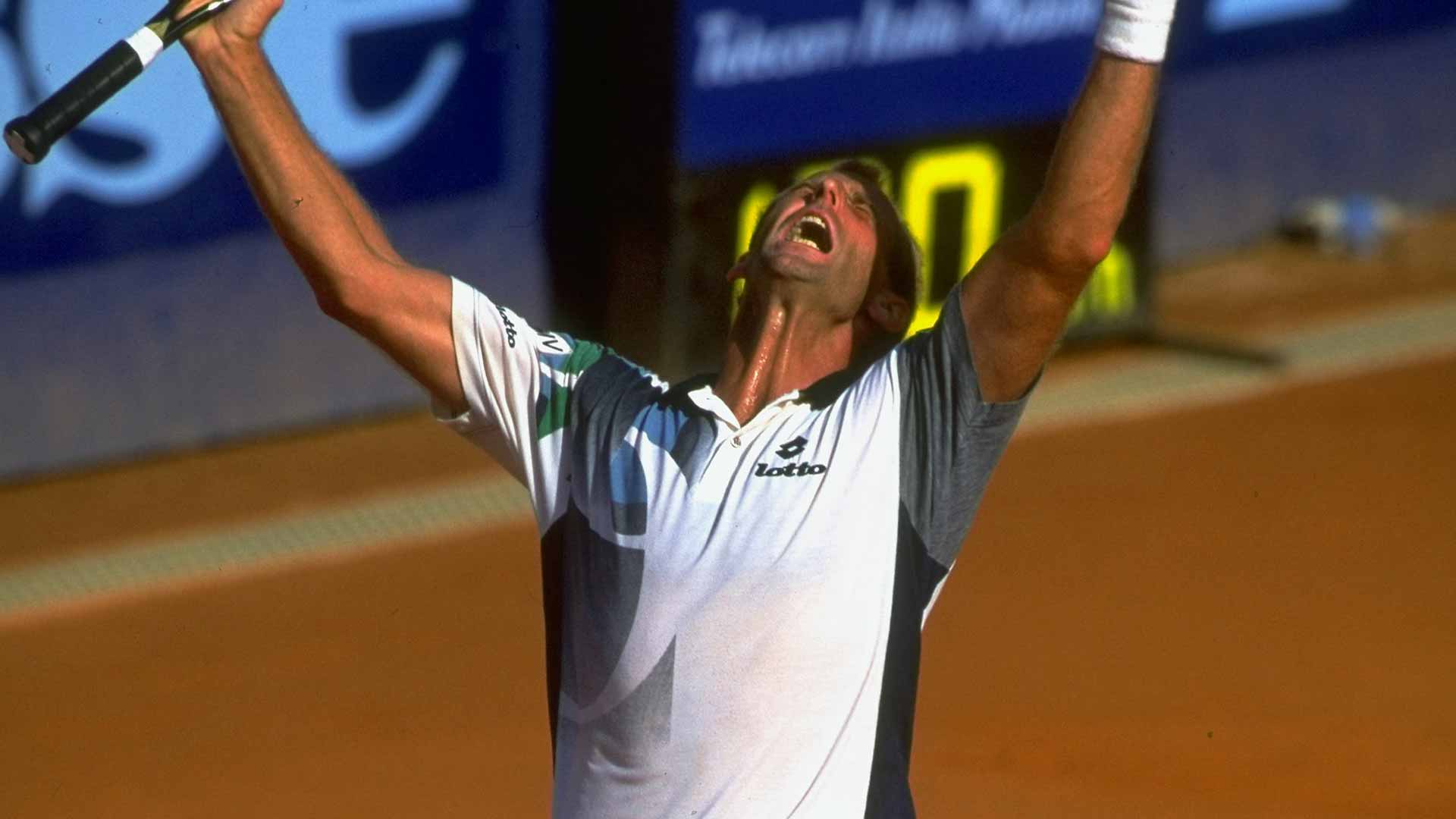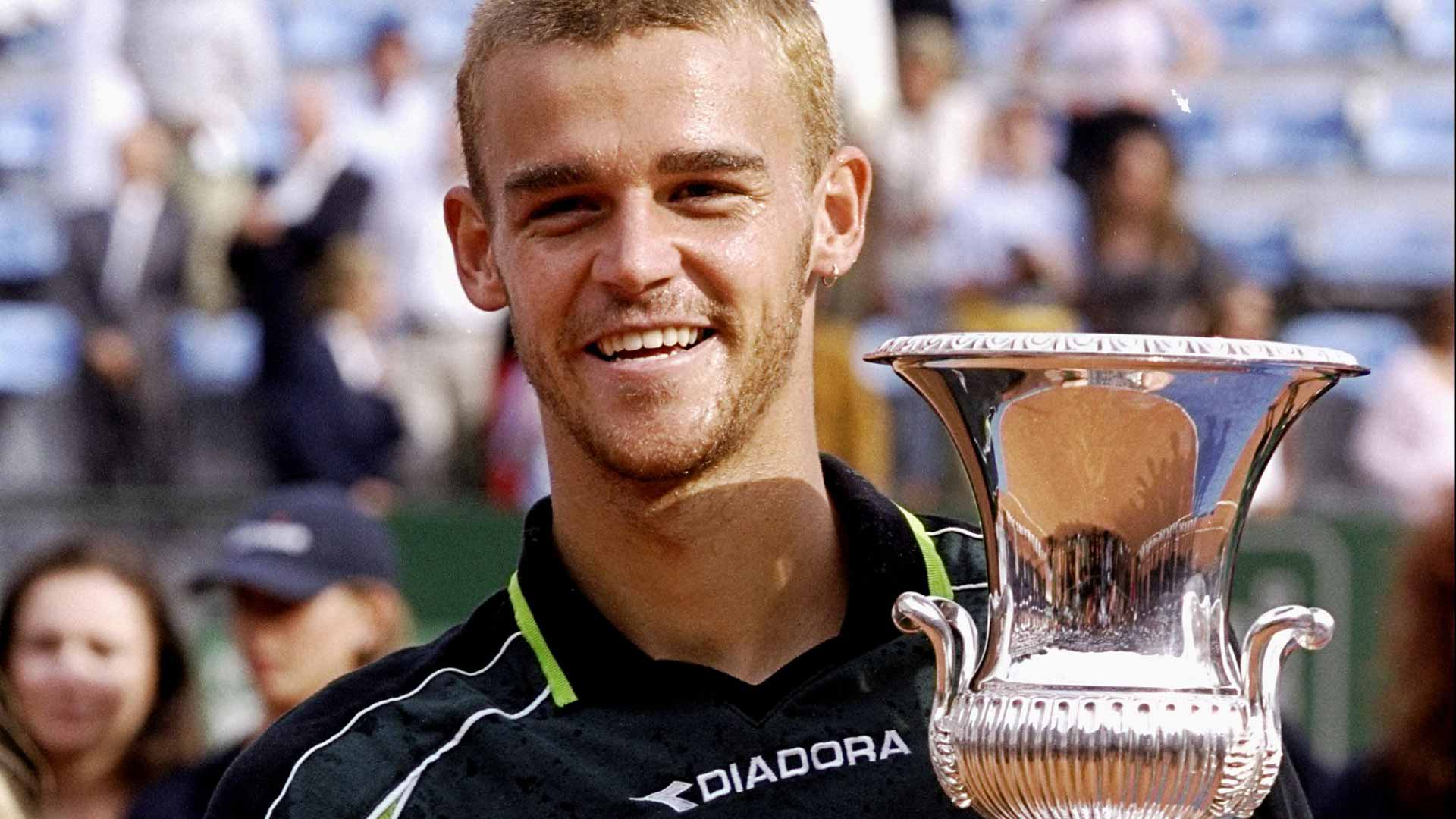Rafa, Novak & The Foro Italico Emperors
Rafa, Novak & The Foro Italico Emperors
Celebrating 30 years of ATP Masters 1000 tournaments, ATPTour.com looks back on memorable moments from Rome since 1990
Normally at this time of season, the Tour heads to historic Foro Italico in Rome. Sadly, the tournament this year was suspended due to the global COVID-19 pandemic, but fans can still celebrate the 30th anniversary of ATP Masters 1000 tournaments. This week, ATPTour.com reflects on some of the memorable moments from the Internazionali BNL d’Italia.
The Italian championship was first held in Milan in 1930, but moved to the Foro Italico, on the slopes of the Monte Mario, five years later. With a total of 11 clay courts, the complex boasts three show courts, the Campo Centrale, Stadio Pietrangeli, named after the 1957 and 1961 champion Nicola Pietrangeli, and the Supertennis Arena. It has been a combined ATP/WTA event since 2011.
1992-1993: Peak Courier
At the peak of his powers, Jim Courier stormed the Foro Italico to become the first player to win back-to-back Rome titles since Jaroslav Drobny in 1950 and 1951. While victories over Carlos Costa and Goran Ivanisevic in the 1992 and 1993 finals, respectively, were not memorable, suspense-laden classics, it was the nature of Courier’s performances that were. Starting off at a high pace and displaying the kind of mental toughness that became his trademark, the American fought past the likes of Thomas Muster, Francisco Clavet, Sergi Bruguera and Carl-Uwe Steeb in 1992, then Bruguera (again) and Michael Chang in 1993 en route to his historic triumphs. He was the preeminent dirt-baller, at a time when then-Tournament Director Franco Bartoni, Cino Marchese, former champion Adriano Panatta and Sergio Palmieri developed the commercial reputation of Rome, and it’s organisation.
1994: Sampras Becomes Emperor
Pete Sampras won three clay-court titles, but none was bigger than on 9 May 1994, when he thrashed Boris Becker 6-1, 6-2, 6-2 in the Rome final to extend his match wins record to 27 and his season tally to 39-2, which included his seven trophies. Becker admitted, “He is playing tennis like they will play the game in the 21st century. He’s doing things I’ve never seen before on a tennis court. I can only compare him to the greatest of the greats. He just beat the heck out of me today.” Sampras, who did not serve as well as he had earlier in the week, was able to put pressure on Becker’s serve, winning 27 of 44 points and breaking six times. “I played really well today,” said Sampras. “I made very few errors and I was pretty much in control from the outset. Boris was never able to accomplish his game plan, or to work into any sort of rhythm. I was moving much better today than I had been all week. I also felt much better at net. I had my balance. This is the result of playing a week on clay.”

1995-1996: The Magic Of Muster
Just six weeks after a freak accident damaged left knee ligaments in Miami, Thomas Muster put in an appearance at the Foro Italico, where he told then-Tournament Director Franco Bartoni, “I’ll be back next year and win.” Few believed him, but Muster was true to his word. In the first year of Masters 1000 tournaments, the Austrian ironman beat Andrei Chesnokov 6-1, 6-3, 6-1 in the 1990 final. Five years on, having waited a long time for the rain to stop, Muster dismissed Sergi Bruguera 3-6, 7-6(5), 6-2, 6-3 for his 28th straight win on red dirt. A few weeks later, the 27-year-old completed the title hat-trick of Monte Carlo, Rome and Roland Garros title in the same year, a feat only achieved by Ilie Nastase (at the time) in 1973. The following year, the supremely fit Muster, not quite at the peak of his powers, mastered a swirling wind and wet conditions to beat the serve-volleyer Richard Krajicek 6-2, 6-4, 3-6, 6-3 for his fifth title of 1995. It extended his record on clay over the past two years to 95-3. He joined Jaroslav Drobny (1950-51, 1953) and Marty Mulligan (1963, 1965 and 1967) — at the time — as the only men to win the Italian Open three times.

1999: Guga Reigns, Denies Rafter No. 1
Gustavo Kuerten, the charismatic Brazilian, ended the hope of Patrick Rafter rising to No. 1 in the FedEx ATP Rankings with a fine all-court display against the traditional serve-volleyer, the first Australian in the Rome final since fellow Queenslander Rod Laver in 1971. Kuerten moved back into the Top 10 with a 6-4, 7-5, 7-6(6) victory over Rafter in two hours and 39 minutes. “I didn’t get my serve together the whole match,” he lamented, adding, “I would always struggle against Kuerten on clay.” Rafter saved break points in the fifth, ninth and 11 games prior to a tense third-set tie-break, which ended his hopes of joining John Newcombe as World No. 1. Kuerten, the No. 16 seed, who beat Fernando Vicente, Francisco Clavet, No. 1 Yevgeny Kafelnikov, Karol Kucera and Alex Corretja en route to the 1999 final, completed the win with a backhand return and angled backhand volley winner. Kuerten, who made his Rome debut in 1998, compiled a 19-3 record at the tournament in his first four appearances. He also finished runner-up in 2000 to Magnus Norman and 2001 to Juan Carlos Ferrero.
2002: Agassi Wins, At Last!
Andre Agassi, with his two-toned shoulder length hair and denim shorts, could only smile, when he captured the 2002 crown, 13 years after first reaching the Rome final. The recently turned 19-year-old had not dropped a set en route to the 1989 championship match, the biggest final of his four-season career to-date. But he lost to Alberto Mancini in five sets. The American then skipped the event in seven of the next 12 seasons, but prior to 2002, when he arrived at the Foro Italico on the back of a right wrist injury, Agassi was in top form, reaching three finals. With Lleyton Hewitt and Kuerten leading every member of the Top 10 in the field, Agassi didn’t drop a set once more to the final, where he beat Tommy Haas 6-3, 6-3, 6-0. Acknowledging Mancini, Agassi said, “Hopefully, wherever Alberto Mancini is, he has a smile on his face for me.” Agassi’s 2002 Rome title remains the last ATP Masters 1000 crown won my an American on clay.
2005: Nadal Wins Battle For The Ages
Three weeks on from the Rolex Monte-Carlo Masters, Rafael Nadal met Guillermo Coria, the most dangerous clay-court player of the past 12 months, once more in a highly anticipated final. In one of the greatest finals in ATP Tour history, 18-year-old Nadal recovered from 0-3 down in the deciding set to beat Coria 6-4, 3-6, 6-3, 4-6, 7-6 to extend his winning streak to 17 matches. “This was the best match of my career,” said Nadal. “It was such a tough match. I’m so happy to have won, it’s unbelievable. I have won three consecutive titles, I don’t know how to explain that.” The win maintained Spain’s hold on the Rome title, following triumphs for Ferrero in 2001, Felix Mantilla in 2003 and Carlos Moya in 2004. Devastated by the loss, Coria said, “I’m a little bit disappointed because I ran for five hours just to lose with two points. Actually, I am very disappointed. It’s normal, but I lost to a top player who played a great match. So that’s it, now I have to move on. I think I was pretty close to beating him today, but he’s very confident. He has won a lot of matches lately and he’s making some incredible shots.”
2006: Two Stars Collide
Twelve months on and the Roman crowd watched another treat, this time the day Nadal and Federer cemented their rivalry in a superb 6-7(0), 7-6(5), 6-4, 2-6, 7-6(5) final victory, which had taken eight minutes longer than the 2005 title match. At 19 years of age, Nadal had tied Guillermo Vilas’ Open Era record of 53 straight match wins on a clay. Nadal, who’d beaten Federer in the Monte Carlo final three weeks earlier, admitted, “Before each tournament, I’m always thinking, ‘This week I’m going to lose.’ But I have been lucky this year and won.” With no choice but to attack, Federer gained a stranglehold at 4-1 in the fifth set and held two championship points after Nadal hit the first double fault of the match at 5-6, 15/30. The Swiss squandered hit first opportunity with a backhand long, then rushed a forehand down the line to let Nadal off the hook. “I tried to hit a winner, why not?” said Federer, who finished on 89 unforced errors. “I didn’t try to totally hit a winner, but tried to play aggressive and I was a little late on it. I couldn’t get quite over the first point in time. I guess, the first match point cost me the match.” The win, Nadal’s 13th straight final triumph, also tied Bjorn Borg’s record for 16 titles won as a teenager. At 57 games, the 2006 encounter was the longest Rome final in terms of games. Read Feature
2008: Djokovic’s First Title, Rome Love Affair
While the surname Nadal dominates the roll of honour since 2005, Novak Djokovic has also been successful with four titles from nine finals. A few months after capturing his first major title, Djokovic battled hard to beat Stan Wawrinka 4-6, 6-3, 6-3 in the 2008 final for his fourth Masters 1000 crown and by 2011, amidst a 41-match winning streak for the season, the undisputed World No. 1 overcame Nadal 6-4, 6-4 in the Rome final. In 2014, having overcome a right wrist injury, Djokovic beat Nadal in a final for the fourth straight time, 4-6, 6-3, 6-3, and the following year, recorded the 22nd of a 28-match winning streak to beat Federer 6-4, 6-3. On three occasions, Djokovic lost to Nadal in the Rome final (2009, 2012 and 2019), while he fell at the final hurdle to Andy Murray in 2016 and Alexander Zverev in 2017. Overall, the Serbian has not lost before the quarter-finals in 13 appearances (to date).
2019: Nadal On Cloud Nine
If he wasn’t quite in top form, Nadal was certainly close to it upon capturing a record-extending crown in Rome. His 6-0, 4-6, 6-1 victory over Djokovic after two hours and 25 minutes gave Nadal his ninth title (2005-07, 2009-10, 2012-13, 2018-19) in 11 Rome finals (also 2011, 2014). “What means most to me is this trophy,” said Nadal, who has recorded 84 match wins at the Masters 1000 tournament. “Rome is one of the most important tournaments of the year. [It’s a big] part of the history of our sport. To be able to win here again is the main thing.” The 39-minute opener was the first 6-0 set between the rivals, contesting their 54th meeting, in 141 previous sets. Read Final Match Report & Watch Highlights

